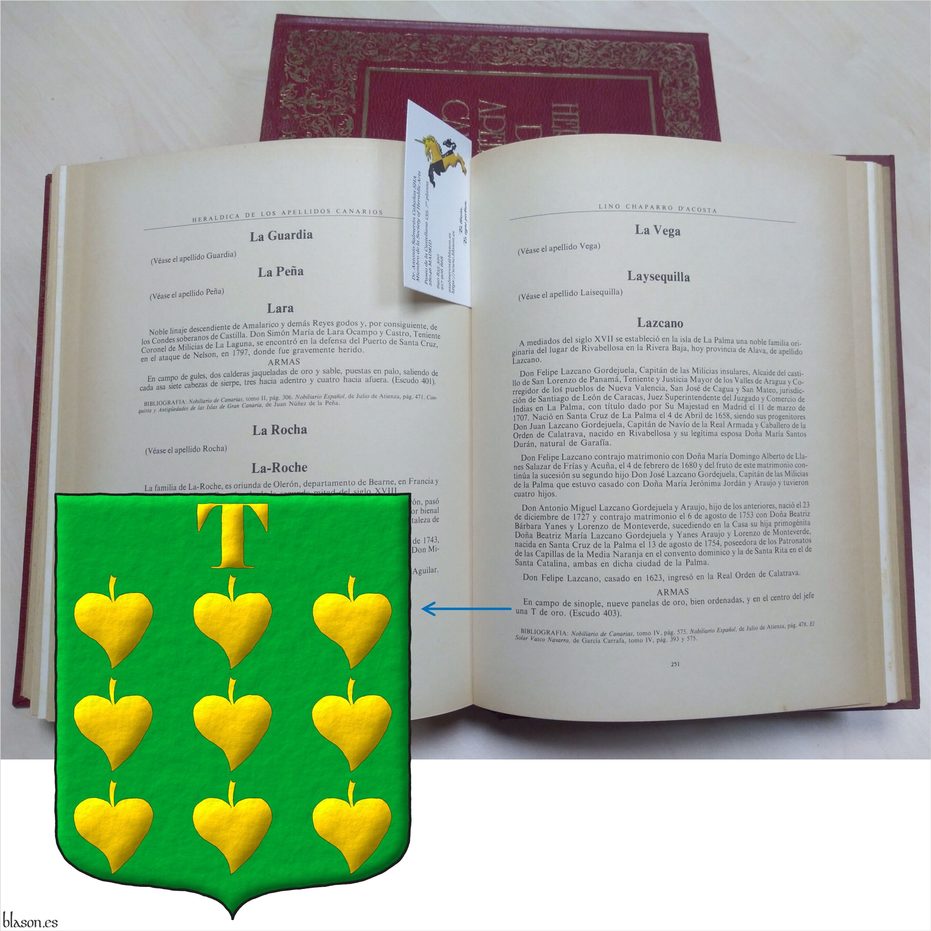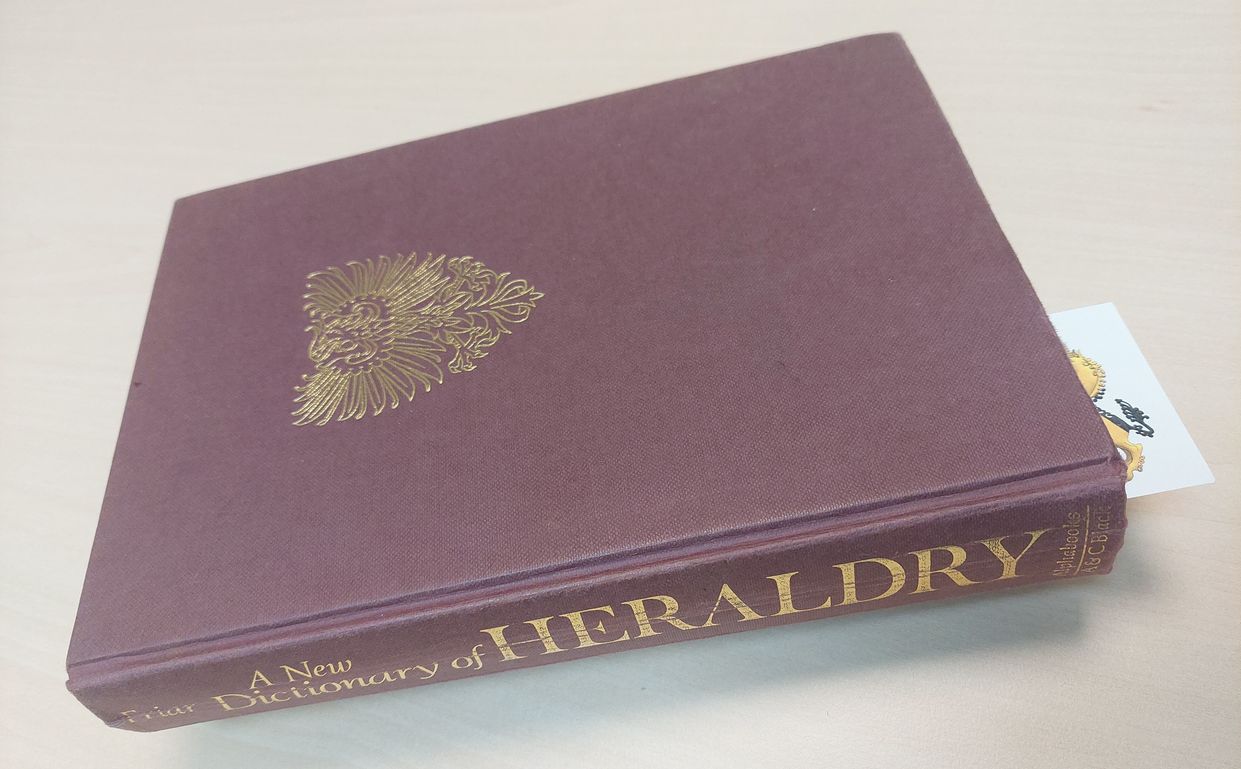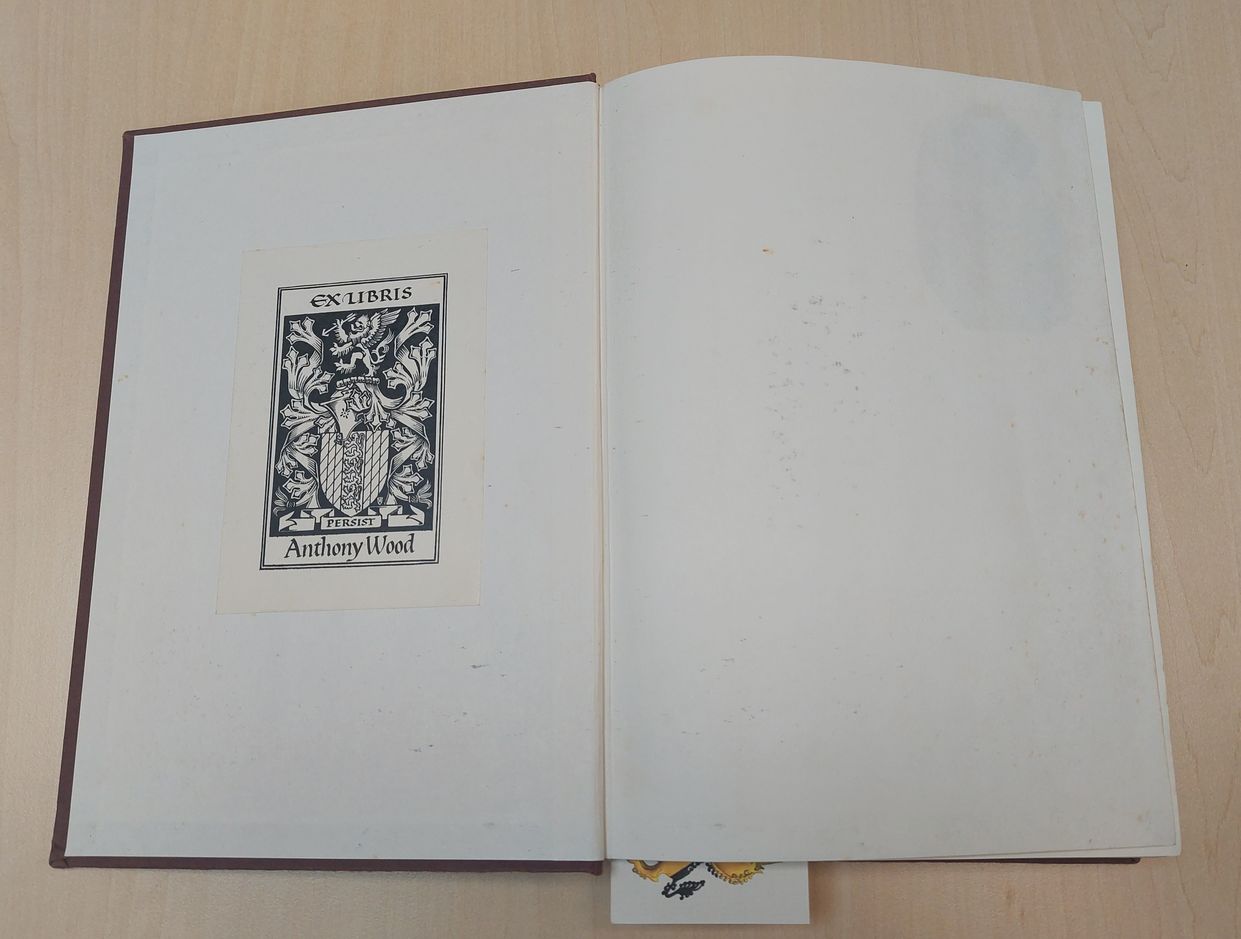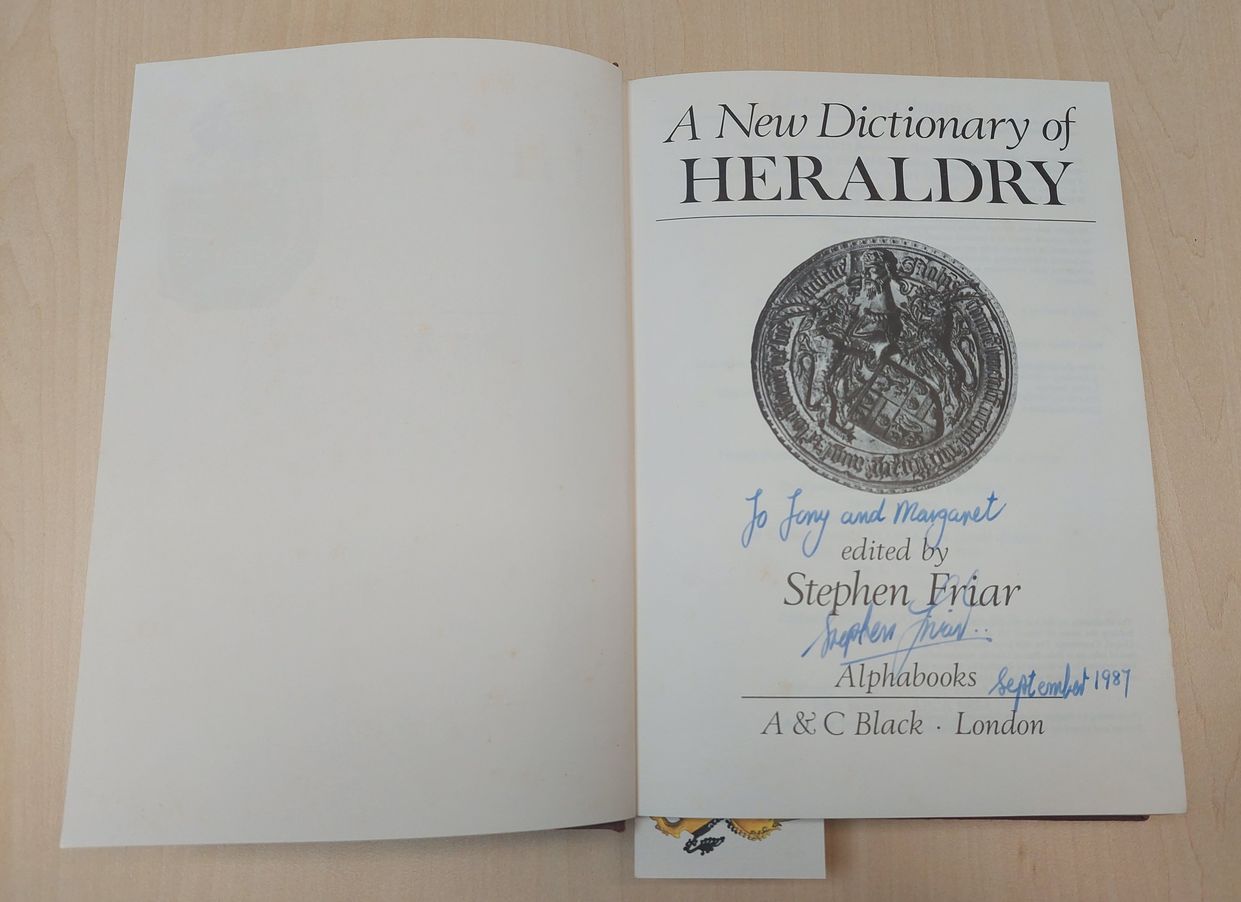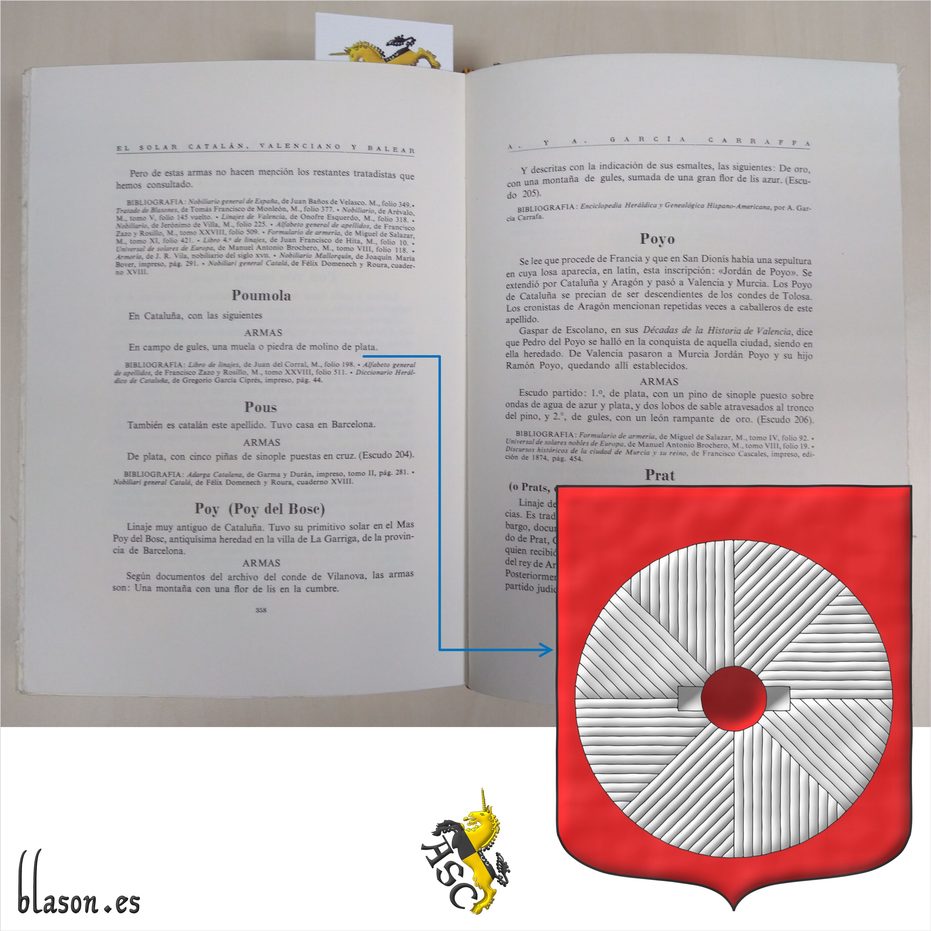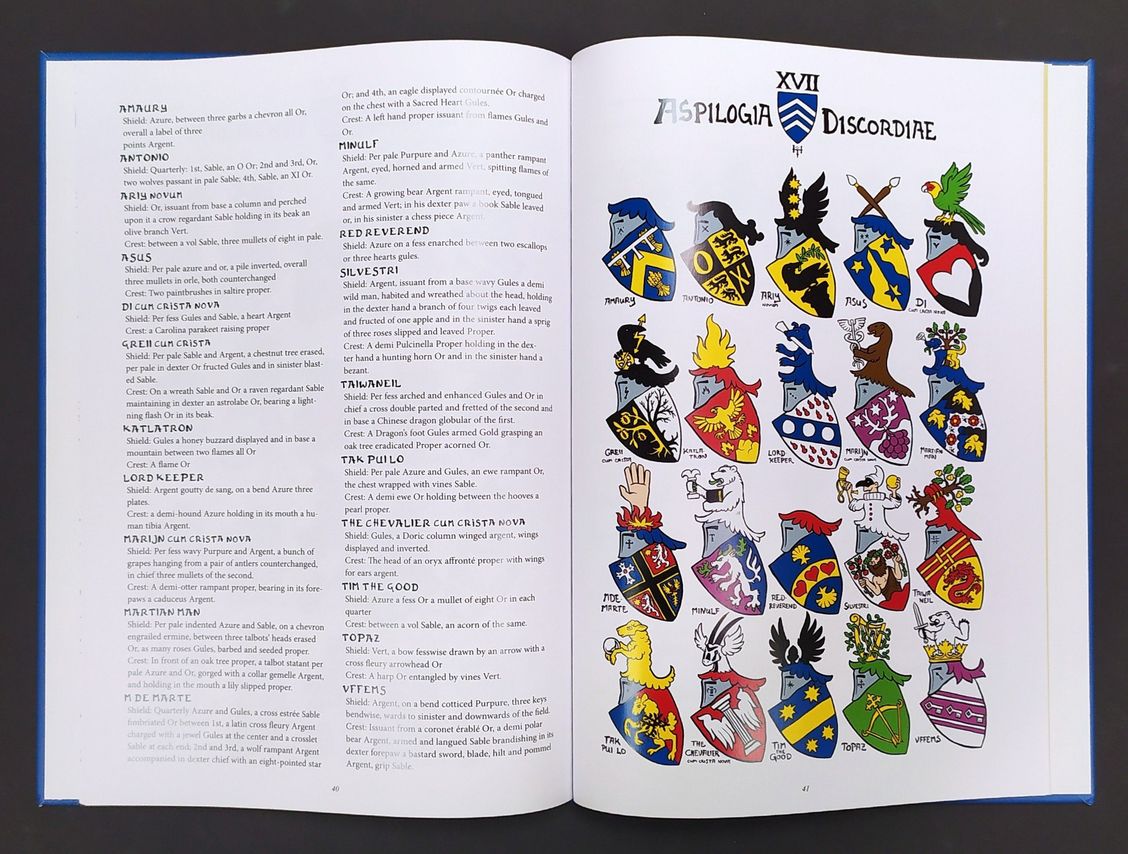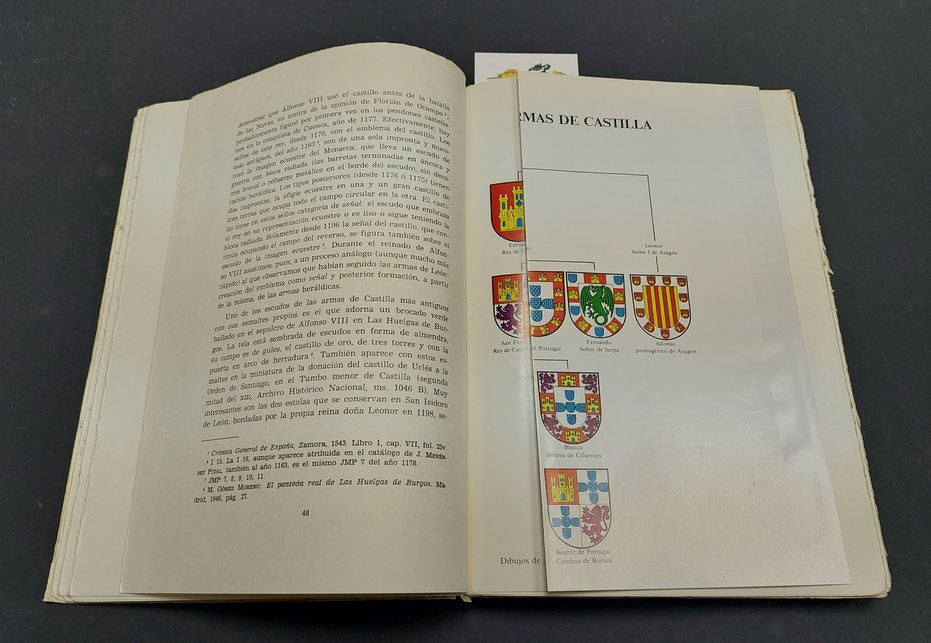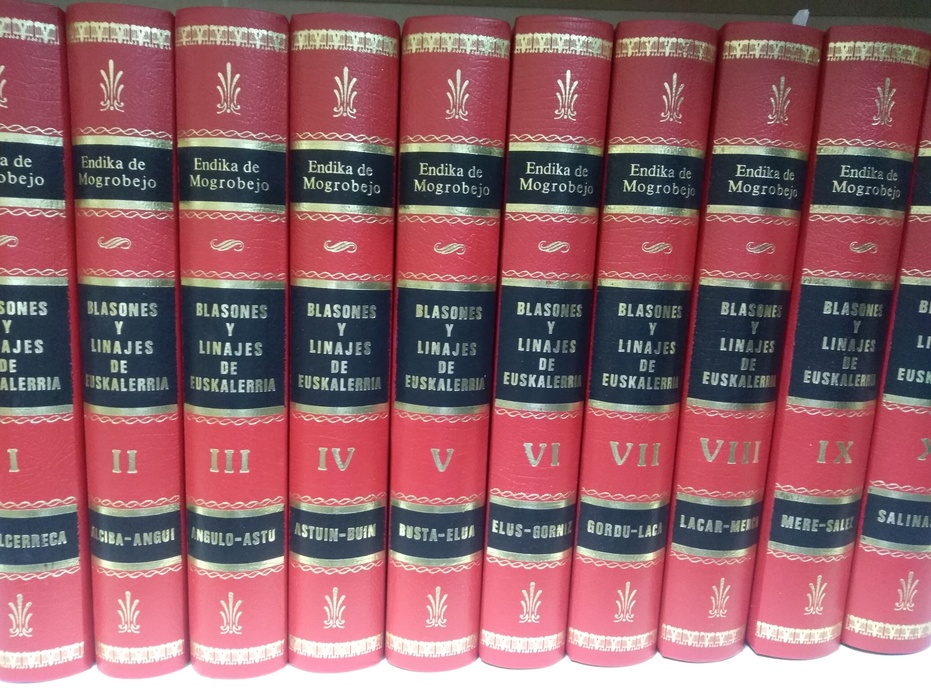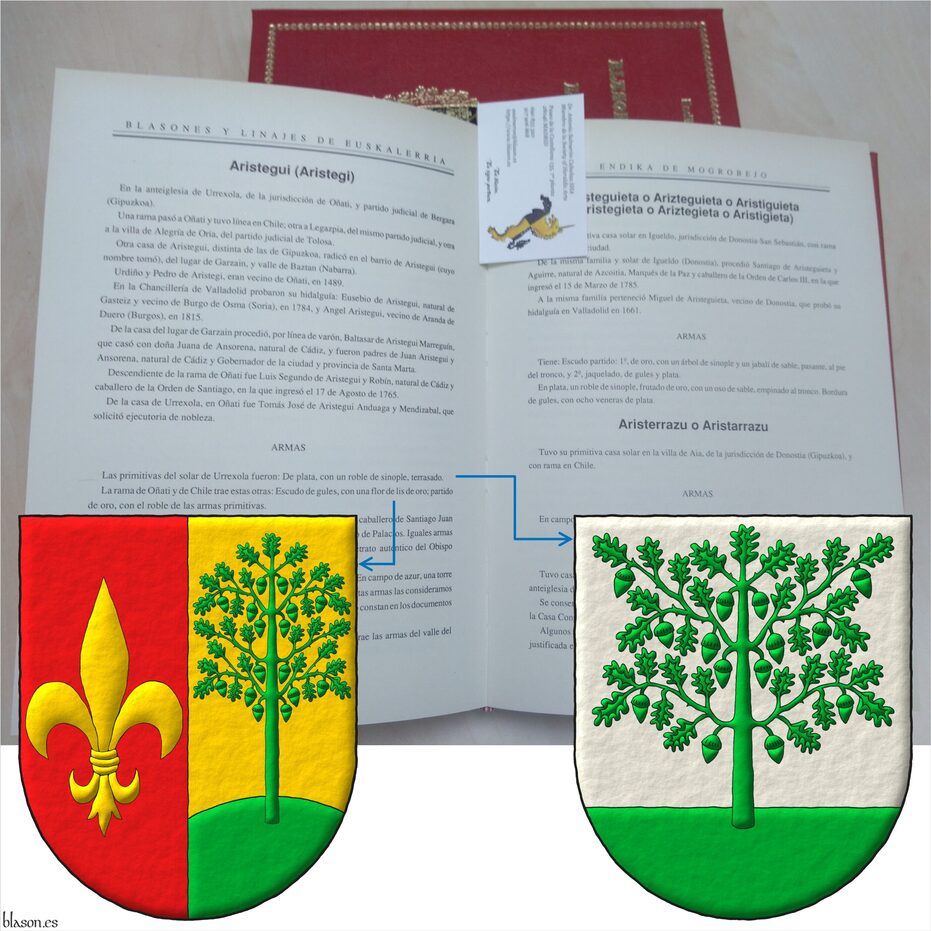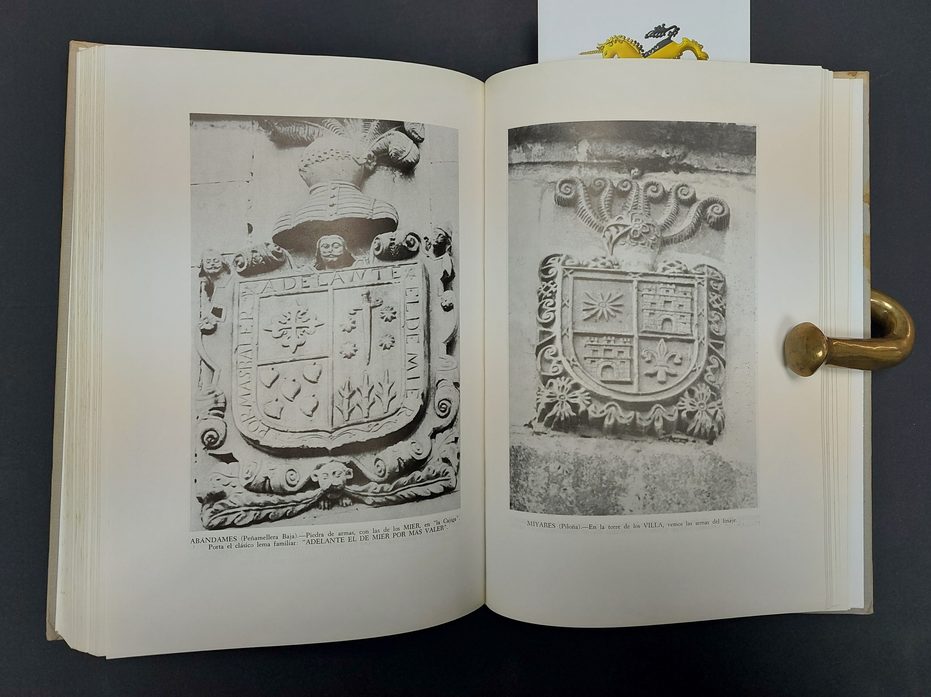Black and white with color plates


![Ver [Chaparro D'Acosta L.; 1979] en referencias bibliográficas. Libro abierto, hojas de plata, filo de oro, guardas de gules, tapas de sable.](../css/Libro.Bibliografia.png)
Chaparro D'Acosta L.; 1979
Lino Chaparro D'Acosta, «Heráldica de los Apellidos Canarios», foreword by Vicente de Cadenas y Vicent, 2 volumes, Volume I from A to L, 285 surnames, 293 pages, Volume II from M to Z and a heraldic dictionary, 387 surnames, 439 pages, edited by Estudios Tecnicos del Blason, ISBN of the complete work 84-300-2000-4, ISBN of Volume I 84-300-1989-8, ISBN of Volume I II 84-300-418010-8, Las Palmas de Gran Canaria, 1979.
Bibliographical reference of century XX.
Classification: Black and white with color plates and Castilian language.
The author is Chaparro D'Acosta, Lino.
The following article cites this bibliographic reference:


![Ver [Cramer, R. de; 1913] en referencias bibliográficas. Libro abierto, hojas de plata, filo de oro, guardas de gules, tapas de sable.](../css/Libro.Bibliografia.png)
Cramer, R. de; 1913
René de Cramer, «Drapeaux, Bannières, Vlaggen en Wimpels», Universal and International Exhibition of Ghent 1913, La Vieille Flandre, published by Société Anonyme Belge d'Imprimerie, Brussels, 1913.
Bibliographical reference of century XX.
Classification: French language, Dutch language and Black and white with color plates.
The author is Cramer, René de.
Internal resources: CramerRde913.DrapeauxBannir.docx.

![Ver [Durasov, V. A.; 1906] en referencias bibliográficas. Libro abierto, hojas de plata, filo de oro, guardas de gules, tapas de sable.](../css/Libro.Bibliografia.png)
Durasov, V. A.; 1906
Vladimir Alexandrovich Durasov, «Heráldica de la Nobleza de toda Rusia», 279 páginas, San Petersburgo, 1906.
Descripción
Esta obra, escrita por V. A. Durasov, es un registro heráldico completo de la nobleza rusa. Proporciona ilustraciones de los escudos de armas de las familias nobles a lo largo del Imperio Ruso.
El nombre completo del autor es Vladimir Alexandrovich Durasov, aunque en algunas fuentes, especialmente en versiones traducidas o abreviadas, puede aparecer como «W. Durasov» debido a problemas comunes de transliteración del ruso al alfabeto latino.
La obra se cita comúnmente como publicada en 1906, según se indica al inicio del libro; sin embargo, la fecha en la última página del libro es 1907.
Bibliographical reference of century XX.
Classification: Armorial roll, Russian language and Black and white with color plates.
The author is Durasov, Vladimir Alexandrovich.
Internal resources: DurasovVA1906.HeraldicaNoblezaRusa.pdf Formato PDF.


![Ver [Friar, S.; 1987] en referencias bibliográficas. Libro abierto, hojas de plata, filo de oro, guardas de gules, tapas de sable.](../css/Libro.Bibliografia.png)
Friar, S.; 1987
Stephen Friar, «A Dictionary of Heraldry», first edition, illustrated by John Ferguson, Andrew Jamieson, and Anthony Wood, 384 pages, Harmony Books, ISBN.10 0-517-56665-6, New York, 1987.
This work exists under two published titles, «A Dictionary of Heraldry» and «A New Dictionary of Heraldry». The physical copy in my possession corresponds to the latter.
The physical copy in my possession originates from the personal library of Anthony Wood, one of the illustrators of the work, as evidenced by his ex libris. His library was offered for sale by R. G. Watkins Books and Prints, Somerset, from which I personally acquired a small, selected group of heraldry and heraldic art books.
This book is a comprehensive dictionary that explains the meanings of many heraldic symbols and discusses aspects of the history of heraldry. Stephen Friar, Director of The Society of Heraldic Arts, compiled this work with contributions from renowned heraldic illustrators. It is a valuable resource for anyone interested in heraldry, providing detailed descriptions and illustrations of heraldic terms and symbols.
Bibliographical reference of century XX.
Classification: De bibliotheca, Ex bibliotheca Anthony Wood, Dictionary, English language and Black and white with color plates.
Author: Friar, Stephen.
The following articles cite this bibliographic reference:
External links:
Internal resources: A Dictionary of Heraldry - FriarS1987.ADictionaryOfHeraldry.pdf and A New Dictionary of Heraldry - Physical book on paper.


![Ver [García Carraffa, A.; García Carraffa, A.; 1920] en referencias bibliográficas. Libro abierto, hojas de plata, filo de oro, guardas de gules, tapas de sable.](../css/Libro.Bibliografia.png)
García Carraffa, A.; García Carraffa, A.; 1920
Alberto García Carraffa y Arturo García Carraffa, «Heraldic and Genealogical Dictionary of Spanish and American Surnames», 88 volumes, printed by Antonio Marzo, Madrid, 1920.
Contents of the 88 volumes
- Volume I. The science of heraldry or blazon.
- Volume II. Dictionary of blazonry terms; Methods of blazoning; Index of heraldic.
- Volume III. Aanda - Adan de Yarza.
- Volume IV. Adana - Aich.
- Volume V. Aichiaivoli - Alcocer.
- Volume VI. Alcoces - Almuzara.
- Volume VII. Aloi - Alzuru.
- Volume VIII. Allado - Anés.
- Volume IX. Anescar - Aragón.
- Volume X. Aragonés - Arecha.
- Volume XI. Aréchaga - Aronal.
- Volume XII. Aronsena - Azzia.
- Volume XIII. Baana - Barbena.
- Volume XIV. Barbens - Basani.
- Volume XV. Basanta - Benavides.
- Volume XVI. Bencarza - Blancazo.
- Volume XVII. Blanco - Bolet.
- Volume XVIII. Boliaga - Brañas.
- Volume XIX. Braramuño - Buzón.
- Volume XX. Caamaño - Cadelo.
- Volume XXI. Cadena - Campani.
- Volume XXII. Campano - Cañellas.
- Volume XXIII. Cañete - Caroli.
- Volume XXIV. Carondelet - Cassador.
- Volume XXV. Castant - Celaeta.
- Volume XXVI. Celain - Claver.
- Volume XXVII. Claveria - Cutuneguieta.
- Volume XXVIII. Chavelas - Desportell.
- Volume XXIX. Despou - Duzay.
- Volume XXX. Ebazquin - Ellauri.
- Volume XXXI. Ellul - Escolonea.
- Volume XXXII. Escorcia - Ezterripa.
- Volume XXXIII. Fabalis - Fernández de Espinosa.
- Volume XXXIV. Fernández de Estenoz - Figuereido.
- Volume XXXV. Figuera - Franco.
- Volume XXXVI. Francoli - Gamboa.
- Volume XXXVII. Gambacorta - García de la Plata.
- Volume XXXVIII. García y Portilla - Gil de Zúñiga.
- Volume XXXIX. Gilabert - Gómez de la Serna.
- Volume XL. Gómez de Silva - Gorriti.
- Volume XLI. Górriz - Guil.
- Volume XLII. Guilisagasti - Haro.
- Volume XLIII. Hartos - Hilera.
- Volume XLIV. Hilgueros - Ibarrundia.
- Volume XLV. Ibars de Povil - Irazusta.
- Volume XLVI. Irgas - Izurzu.
- Volume XLVII. Jabaloyas - Juyá.
- Volume XLVIII. Labaca - Larburu.
- Volume XLIX. Lardíes - Lazcamburu.
- Volume L. Lazcano - Lizárraga.
- Volume LI. Lizarralde - Luzuriaga.
- Volume LII. Llabiá - Malda.
- Volume LIII. Maldonado - Marín.
- Volume LIV. Marina - Marroquin.
- Volume LV. Marrubiza - Mendibure.
- Volume LVI. Mendicoa - Mesares.
- Volume LVII. Mescua - Moncayo.
- Volume LVIII. Monclares - Moradell.
- Volume LIX. Moraga - Mozo.
- Volume LX. Mozo de la Torre - Muzúa.
- Volume LXI. Naarruza - Nelia.
- Volume LXII. Neira - Ocaranza.
- Volume LXIII. Ocariz - Olcina.
- Volume LXIV. Olcinellas - Ordines.
- Volume LXV. Ordonias - Oruna.
- Volume LXVI. Oruña - Ozticain.
- Volume LXVII. Pablo or de Pablo - Palandegui or Palantegui.
- Volume LXVIII. Palafurgell - Parro.
- Volume LXIX. Parrondo - Pellón.
- Volume LXX. Pemán - Pérez de Arramendia.
- Volume LXXI. Pérez de Arroyo - Pillado.
- Volume LXXII. Pimentel - Poli.
- Volume LXXIII. Polo - Portero.
- Volume LXXIV. Portes - Puig - Gat.
- Volume LXXV. Puigbaco - Quincoces.
- Volume LXXVI. Quinquer - Rami.
- Volume LXXVII. Ramírez - Rezusta.
- Volume LXXVIII. Riabeyo - Rizo.
- Volume LXXIX. Roa - Romaza.
- Volume LXXX. Romero or Romeo, O Romeu - Ruy de Peras.
- Volume LXXXI. Sáa - Salinas.
- Volume LXXXII. Sall - Santángel or Sant Angel.
- Volume LXXXIII. Santaolaria or Santolaria - Sayola.
- Volume LXXXIV. Sebastián - Sirtema.
- Volume LXXXV. Sirvent or Sirvente - Susunaga.
- Volume LXXXVI. Tabar or Tavar - Tolosans.
- Volume LXXXVII. Tolrá - Tutor.
- Volume LXXXVIII. Uacué - Urriza.
Bibliographical reference of century XX.
Classification: Castilian language and Black and white with color plates.
Authors: García Carraffa, Alberto and García Carraffa, Arturo.
External resources:
Internal resources: GarciaCarrafiaAyA1920.Tomo.01.pdf PDF format, GarciaCarrafiaAyA1920.Tomo.04.pdf PDF format and GarciaCarrafiaAyA1920.Tomo.08.pdf PDF format.


![Ver [García Carraffa, A.; García Carraffa, A.; 1968] en referencias bibliográficas. Libro abierto, hojas de plata, filo de oro, guardas de gules, tapas de sable.](../css/Libro.Bibliografia.png)
García Carraffa, A.; García Carraffa, A.; 1968
Alberto García Carraffa y Arturo García Carraffa, with the colaboration of Armando de Fluviá y Escorsa, «El Solar Catalán, Valenciano y Balear», 4 volumes, Volume I Abad-Cebrián, 443 pages, Volume II Celma-Malda, 449 pages, Volume III Malendric-Quirant, 425 pages, Volume IV Rabasa-Zenarbe y apéndice, 516 pages, 1st edition, Heraldic Collection, edited by Librería Internacional, San Sebastián, 1968.
Bibliographical reference of century XX.
Classification: Castilian language and Black and white with color plates.
Authors: García Carraffa, Alberto and García Carraffa, Arturo.
The following articles cite this bibliographic reference:
Internal resources: Paper book.


![Ver [Halkosaari, H.; Prica, D.; 2023] en referencias bibliográficas. Libro abierto, hojas de plata, filo de oro, guardas de gules, tapas de sable.](../css/Libro.Bibliografia.png)
Halkosaari, H.; Prica, D.; 2023
Heikki Halkosaari, heraldic artist, Dimitri Prica, editor, «Aspilogia Discordiae 2022, A collection of armorial bearings from the Heraldry Community», 64 pages, A4 dimensions, 8.27 x 11.69 inches, 210 x 297 milimeters, even pages in black and white for blazons and odd pages in color for coats of arms, hardcover, 2023.
Description
This book collects a wide variety of armorial bearings from the Discord Heraldry Community. Although titled 2022, the book was officially published on the 12th of February of 2023. It features the contribution of many collaborators, including heraldic designs, layout, and editorial coordination.
One of the final sections includes a comprehensive list of contributors, such as:
- Loggail, Heikki Halkosaari: Artist, Legend
- Dilan Nunes: Archivist, Wizard
- Michael Plasom-Scott: Layout, Complimentary Art
- Novov: Data Wrangling, Light in the Darkness
- Gel Gems: Outreach, Scambot
- Jacques: Coordination, Production research
- John Morales: Coordination, Production Research
- Zaberqiq: Blazon Gathering
- M-I-K-E: Blazon Gathering, Introduction
- Al-Shamshoon: Blazon Gathering, Production Research
- Imperial: Blazon Gathering, Coordination
- Benjolicious: Blazon Gathering
- CleihCarp: Blazon Gathering
- Edward Teather: Blazon Gathering
- Quentin Lamb: Blazon Gathering
- Pierre Scheips: Blazon Gathering
- Quentin Peacock: Complimentary Art
- Fritz Jahn: Complimentary Art
- Björn Friden: Complimentary Art
- Aaron Mitton: Print Consultant
- Kevin Haelterman: Patron
- Jan Bobor: Patron
- Matt: Map Coordination and Realization
- Dimitri Prica: Editor in Chief
Bibliographical reference of century XXI.
Classification: De bibliotheca, English language, Black and white with color plates and Armorial roll.
The 2 authors are Halkosaari, Heikki and Prica, Dimitri.
External link:
Internal resources: AspiologiaDiscordiae.Book.26.Laminas.pdf PDF with 26 color plates, AspiologiaDiscordiae.Book.Part01.pdf First part in PDF, AspiologiaDiscordiae.Book.Part02.pdf Second part in PDF and Physical book on paper.


![Ver [Lindsay, D.; 1822] en referencias bibliográficas. Libro abierto, hojas de plata, filo de oro, guardas de gules, tapas de sable.](../css/Libro.Bibliografia.png)
Lindsay, D.; 1822
Sir David Lindsay, «Facsimile of an Ancient Heraldic Manuscript Emblazoned by Sir David Lyndsay of the Mount, Lyon King of Arms, 1542», engraved by W. H. Lizars, published by W. & D. Laing, Edinburgh, 1822.
Bibliographical reference of century XIX.
Classification: English language and Black and white with color plates.
Author: Lindsay, David.
External link:
Internal resources: LindsayD1822.FacsimileHeraldicManuscript.pdf.


![Ver [Menéndez Pidal de Navascués, F.; 1982] en referencias bibliográficas. Libro abierto, hojas de plata, filo de oro, guardas de gules, tapas de sable.](../css/Libro.Bibliografia.png)
Menéndez Pidal de Navascués, F.; 1982
Faustino Menéndez Pidal de Navascués, «Medieval Spanish Heraldry I: The Royal House of Leon and Castile», illustrations by Jaime Bugallal y Vela, edited by the Salazar and Castro Institute, (C. S. I. C. Higher Center for Scientific Research), published by Hidalguía, 271 pages, size 24 x 17 cm, includes color plates, Legal deposit M. 22.165-1982, ISBN 84-00-05150-5, printed by Imprenta Sáez, Madrid, 1982.
Index
- Introduction, page 11.
- Abbreviations, page 22.
- Alfonso VII, page 23.
- Fernando II, page 39.
- Alfonso VIII, page 47.
- The spread of the arms of Castile, schema between pages 48 and 47.
- Alfonso IX, page 71.
- Fernando III, page 87.
- Alfonso X, page 109.
- Origins of differentiated arms, schema between pages 48 and 47.
- Sancho IV, page 129.
- Fernando IV, page 139.
- Alfonso XI, page 141.
- Pedro I, page 157.
- Henry II, page 165.
- John I, page 177.
- Henry III, page 185.
- John II, page 189.
- Henry IV, page 195.
- Isabella and Ferdinand, page 199.
- Children of the Catholic Monarchs, page 207.
- Evolution of the arms of Spain, page 213.
- The House of Austria, page 239.
- The Houses of Two Sicilies and Parma, page 241.
- Arms of Castile and Leon outside the Royal House, page 243.
- Index nominum, page 265.
- Index rerum, page 271.
Bibliographical reference of century XX.
Classification: Black and white with color plates and Castilian language.
The author is Menéndez Pidal de Navascués, Faustino.
Bibliographical reference mentioned in the following article:
Internal resources: Physical book in paper.


![Ver [Mogrobejo Zabala, E. de; 1991] en referencias bibliográficas. Libro abierto, hojas de plata, filo de oro, guardas de gules, tapas de sable.](../css/Libro.Bibliografia.png)
Mogrobejo Zabala, E. de; 1991
Endika de Mogrobejo Zabala, «Blasones y Linajes de Euskalerria», 10 volumes, Volume I A-Alcerreca, Volume II Alciba-Angui, Volume III Angulo-Astu, Volume IV Astun-Bun, Volume V Busta-Elua, Volume VI Elus-Gorniz, Volume VII Gordu-Laca, Volume VIII Lacar-Merca, Volume IX Mere-Salez, Volume X Salinas-Z, edited by Editorial Amigos del Libro Vasco, printed by Grafo SA, ISBN of the complete work 84-7886-026-6, legal Deposit BI-469-1991, Bilbao, 1991.
Bibliographical reference of century XX.
Classification: De bibliotheca, Black and white with color plates and Castilian language.
Author: Mogrobejo Zabala, Endika de.


![Ver [Rumor, S.; 1899] en referencias bibliográficas. Libro abierto, hojas de plata, filo de oro, guardas de gules, tapas de sable.](../css/Libro.Bibliografia.png)
Rumor, S.; 1899
Sebastiano Rumor, «Il Blasone Vicentino Descritto ed Illustrato», published by Venezia, A spese della Società, 310 pages of black and white text, 20 color plates, including: 1 plate at the beginning with 10 coats of arms, and 19 plates at the end, each containing 6 coats of arms, totaling 124 coats of arms, Venice, 1899.
Bibliographical reference of century XIX.
Classification: Italian language and Black and white with color plates.
The author is Rumor, Sebastiano.
External link:
Internal resources: RumorS1899.IlBlasoneVicentino.pdf PDF format.

![Ver [Sarandeses Pérez, F.; 1994] en referencias bibliográficas. Libro abierto, hojas de plata, filo de oro, guardas de gules, tapas de sable.](../css/Libro.Bibliografia.png)
Sarandeses Pérez, F.; 1994
Francisco Sarandeses Pérez, of the Institute of Asturian Studies and of the International Institute of Genealogy and Heraldry, «Heraldry of Asturian Surnames», 408 pages, 89 color plates, black and white illustrations, 27 centimeters, includes bibliography and indexes. prologue to the facsimile edition by Dolores Duque de Estrada Castañeda and Fernando Alós Merry del Val, facsimile edition published by the Royal Institute of Asturian Studies of the José María Quadrado Trust, Superior Center for Scientific Research, printed by Eujoa Artes Gráficas, ISBN 84-87212-26-3, Legal Deposit AS.-1.309/94, Oviedo, 1994.
Reference to the original edition of 1966
The facsimile edition faithfully reproduces the original 1966, [Sarandeses Pérez, F.; 1966], published by the Provincial Council of Oviedo, with a foreword by H.R.H. The Duke of Calabria, prologue by The Hon. Mr. Julio de Atienza, Baron of Cobos de Belchite, and photographs by Mr. Jesús González-Galatea.
Bibliographical reference of century XX.
Classification: De bibliotheca, Castilian language and Black and white with color plates.
Author: Sarandeses Pérez, Francisco.
Internal resources: A facsimile edition as a physical book on paper.


![Ver [Stodart, R. R.; 1881] en referencias bibliográficas. Libro abierto, hojas de plata, filo de oro, guardas de gules, tapas de sable.](../css/Libro.Bibliografia.png)
Stodart, R. R.; 1881
Robert Riddle Stodart, «Scottish Arms: Being a Collection of Armorial Bearings, A.D. 1370-1678», Reproduced in facsimile from contemporary manuscripts with heraldic and genealogical notes, edited by William Paterson, Edinburgh, 1881.
This work is a comprehensive two-volume set that reproduces armorial bearings from various manuscripts dating from 1370 to 1678. The collection includes detailed heraldic and genealogical notes that accompany the facsimiles. It is an essential reference for anyone studying Scottish heraldry and genealogy.
Volume 1
Volume 1 contains an introduction, an alphabetical index of coats of arms, and 125 color plates, each displaying between 1 and 9 coats of arms per plate. This volume 1 is dedicated to the color illustrations of the coats of arms, while volume 2 consists entirely of text without illustrations. In volume 1, the Plates section with color illustrations of coats of arms follows the same structure as volume 2, as will be seen in the section dedicated to volume 2. The contents of volume 1 are as follows.
- Introduction.
- Index to the plates.
- List of names in the order in which they occur on the plates.
-
Plates:
- Armorial de Gelre, pages A to E.
- Armorial de Berry, pages I to II.
- Forman's Roll, pages 12 to 21.
- Sunderland Hall Ms., pages 22 to 24.
- Additions to Sir David Lindsay's Ms., pages 24^ to 34.
- Workman's Ms, pages 35 to 84.
- Kings' and Nobility's arms, pages 85 and 86.
- Sir David Lindsay the Youngers Ms, pages 87 to 94.
- Sir James Balfour's Ms, pages 95 and 96.
- Lyon register, pages 97 and 98.
- Earl of Crawford's Ms., pages 99 and 100.
- Gentlemen's arms, pages 101 to 106.
- Funeral escutcheons, pages 106 to 110.
- Sundries, pages 111 to 118.
- Heraldic and genealogical notes.
- Index to the notes.
- Additions and corrections.
Volume 2
Volume 2 continues the collection and includes further armorial bearings and notes and also references several historical armorials, with the following contents:
- I. The armorial de Gelre, circa 1369.
- II. The armorial de Gilles le Bouvier, Berry Roi d'Armes, circa 1450-55.
- III. Roll of arms, by sir Robert Forman, Lyon King of Arms, circa 1562.
- IV. Sunderland Hall manuscript.
- V. Additions to the booke and register of armes, compiled by sir David Lindsay, Lyon King of Arms.
- VI. Illuminated heraldic manuscript, called "Workman's," circa 1565-6.
- VII. Kings' and nobility's arms, circa 1566.
- VIII. Illuminated manuscript, circa 1603-5, ascribed to sir David Lindsay, Lyon King of Arms.
- IX. Armorial manuscripts by sir James Balfour, Baronet, Lyon King at Arms 1630-54, and another herald.
- X. The public register of all arms and bearings in Scotland, A.D. 1672-78.
- XI. Heraldic manuscript compiled during the reign of James VI, the property of the Earl of Crawford and Balcarres.
- XII. Gentlemen's arms collected during the reign of Charles I.
- XIII. Funeral escutcheons.
- XIV. Sundries.
Bibliographical reference of century XIX.
Classification: Armorial roll, English language and Black and white with color plates.
The author is Stodart, Robert Riddle.
External resources:
Internal resources: StodartR1881.ScottishArms.Heavy.Volume.01.pdf Heavy PDF, StodartR1881.ScottishArms.Heavy.Volume.02.pdf Heavy PDF, StodartR1881.ScottishArms.Light.Volume.01.pdf Light PDF and StodartR1881.ScottishArms.Light.Volume.02.pdf Light PDF.


![Ver [Ströhl, H. G.; 1891] en referencias bibliográficas. Libro abierto, hojas de plata, filo de oro, guardas de gules, tapas de sable.](../css/Libro.Bibliografia.png)
Ströhl, H. G.; 1891
Hugo Gerard Ströhl, «Die Wappen der Buchgewerbe», published by Anton Schroll & Co., 36 pages with black and white illustrations, plus 1 title page, 9 color plates, and 1 additional color plate, Vienna, 1891.
This book is a notable work in the field of heraldry, specifically focusing on the coats of arms related to the book trade industries. Ströhl, a renowned heraldic artist, created detailed illustrations that highlight the symbolism and artistic elements of these armorial bearings. The publication includes a combination of black and white illustrations alongside vivid color plates that showcase the vibrancy of heraldic art in the late 19th century.
Hugo Gerard Ströhl was born on September 24, 1851, in Wels, Austria, and passed away on December 7, 1919, in Mödling, Austria. His works remain influential in the study and appreciation of heraldic art.
Bibliographical reference of century XIX.
Classification: Armorial roll, German language and Black and white with color plates.
The author is Ströhl, Hugo Gerard.
External links:
- Heraldry of the World, Biography of Hugo Gerard Ströhl.
- Payhip download of the book.
- Information about the book at Rice University Library.
Internal resources: Strohl1891.DieWappenDerBuchgewerbe.pdf in PDF format.
-
Language
-
Categories of heraldry
-
Divisions of the field
- Without divisions
- Party per pale
- Party per fess
- Party per bend
- Party per bend sinister
- Tierce
- Tierce sinister
- Tierced per pale
- Tierced per fess
- Tierced per bend
- Tierced pallwise inverted
- Quarterly
- Quarterly per saltire
- Gyronny
- Party per fess, the chief per pale
- Party per pale, the sinister per fess
- Party per fess, the base per pale
- Party per pale, the dexter per fess
- Chapé
- Chaussé
- Embrassé
- Contre-embrassé
- Party per chevron
- Enté
- Enté en point
- Flanched
-
Metals
-
Colours
-
Furs
-
Other tinctures
-
Ordinaries and sub-ordinaries
-
Diminutives of the ordinaries
-
Geometric charges
-
Composite ordinaries
-
Inanimate charges from Nature
Atom, Crescent, Diamond, Emerald, Estoile, Increscent, Lightning flash, Moon, Mount, Mullet, Mullet of four points, Orbital, Plough of Ursa Major, Rainbow, Ray of the sun, River, Sea, Snowflake, Sun, Sun in splendour, Sun of May, Trimount, Water and Wave.
-
Vegetal charges from Nature
Acorn, Apple, Apple tree, Ash, Bluebonnet, Camellia, Chrysanthemum, Cinquefoil, Cornflower, Dogwood flower, Double rose, Elm, Fleur de lis, Flower, Gourd, Holm oak, Hop cone, Kapok tree, Laurel, Lily, Linden, Lotus flower, Madonna lily, Mexican cedar tree, Oak, Olive tree, Palm tree, Plantain plant, Pomegranate, Poplar leaf, Rose, Shamrock, Sunflower, Thistle, Tree, Tulip, Vine and Wheat.
-
Animal charges from Nature
Badger, Bald eagle, Barbel, Barn owl, Bear, Beaver, Beetle, Bighorn sheep, Blackbird, Boar, Brach hound, Bull, Doe, Dog, Dolphin, Dove, Eagle, Elephant, Falcon, Female figure, Fish, Flame, Fly, Fox, Frog, Goat, Goldfinch, Goose, Heron, Horse, Hummingbird, Jaguar, Lark, Leopard, Lion, Lion passant, Lion rampant guardant, Lioness, Lynx, Male figure, Martlet, Merino ram, Owl, Panther, Parrot, Peacock, Pelican, Pelican in her piety, Puffin, Quetzal, Raven, Roe deer, Rooster, Savage, Seagull, Serpent, She-wolf, Stag, Starling, Talbot, Tyger, Vulture, Warren hound and Wolf.
-
Parts of natural charges
Arm, Beak, Branch, Caboshed, Chest, Claw, Covert, Dorsal fin, Eagle claw, Ermine spot, Escallop, Feather, Foot (palmiped), Foreleg, Forepaw, Hand, Head, Heart, Hoof, Leaf, Neck, Ostrich feather, Palm frond, Paw, Roe deers' attires, Shoulder, Sprig, Stags' attires, Stem, Swallow-tail, Tail, Tail addorsed, Tail fin, Talon, Tooth, Trunk, Trunk (elephant), Two hands clasped, Two wings in vol, Udder, Wheat spike, Wing and Wrist.
-
Artificial charges
Ace of spades, Anchor, Anvil, Arch, Arm vambraced, Armillary sphere, Arrow, Axe, Bell, Bell tower, Beret, Bonfire, Book, Bookmark, Bow, Branding iron, Bridge, Broken, Buckle, Cannon, Cannon dismounted, Cannon port, Canopy roof, Carbuncle, Castle, Celtic Trinity knot, Chain, Chess rooks, Church, Clarion, Clay pot, Closed book, Club, Column, Comb, Compass rose, Conductor's baton, Cord, Covered cup, Crozier, Crucible, Cuffed, Cup, Cyclamor, Dagger, Double vajra, Drum, Ecclesiastical cap, Fanon, Federschwert, Fleam, Four crescents joined millsailwise, Galician granary, Garb, Gauntlet, Geometric solid, Grenade, Halberd, Hammer, Harp, Host, Hourglass, Key, Key ward, Knight, Knot, Lantern, Letter, Line, Loincloth, Menorah, Millrind, Millstone, Millwheel, Monstrance, Mortar, Mullet of six points pierced, Nail, Non-classic artifact, Norman ship, Number, Oar, Oil lamp, Open book, Page, Pair of scales, Parchment, Pestle, Piano, Pilgrim's staff, Plough share, Polish winged hussar, Port, Portcullis, Potent, Quill, Ribbon, Rosette of acanthus leaves, Sabre, Sackbut, Sail, Scroll, Scythe, Sheaf of tobacco, Ship, Skirt, Spear, Spear's head, Stairway, Star of David, Step, Sword, Symbol, Tetrahedron, Torch, Tower, Trident, Trumpet, Turret, Two-handed sword, Wagon-wheel, Water-bouget, Wheel, Winnowing fan and With a turret.
-
Immaterial charges
Angel, Archangel, Basilisk, Dragon, Dragon's head, Garuda, Golden fleece, Griffin, Heart enflamed, Justice, Mermaid, Our Lady of Mercy, Ouroboros, Paschal lamb, Pegasus, Phoenix, Sacred Heart of Jesus, Saint George, Sea-griffin, Trinity, Triton, Unicorn, Winged hand and Wyvern.
-
External elements
-
Heraldic creations
-
References
-
Formats
-
Keywords on this page
Armorial roll, Bibliography, De bibliotheca, Dictionary, Black and white with color plates, Ex bibliotheca Anthony Wood, Fleur de lis, Gules, German language, Castilian language, French language, English language, Italian language, Dutch language, Russian language, Letter, Lineage, Nine, Or, Poplar leaf, Party per pale, Millstone, Argent, Without divisions, Kingdom of Castile and Leon, Oak, Century XIX, Century XX, Century XXI, Vert, Terrace in base, One and Tree.

